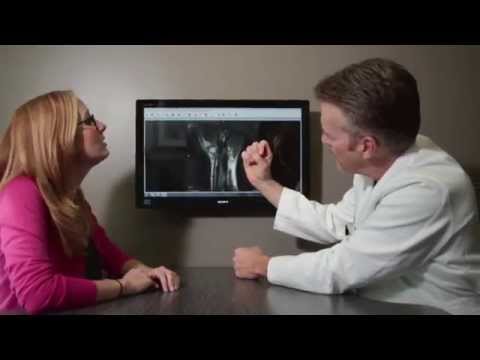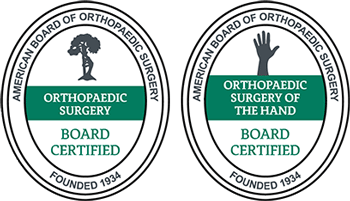Cubital Tunnel Syndrome Treatment in Dallas, TX
Cubital tunnel syndrome is the second most common compression disorder of the peripheral nerve, behind carpal tunnel syndrome. About 25 out of every 100,000 people experience cubital tunnel syndrome each year. It’s an uncomfortable condition that can impede your daily activities, especially if you type or use similar fine motor skills extensively. Let’s learn more about its symptoms and diagnosis so you know when to see a doctor about cubital tunnel syndrome.
Contents
What is Cubital Tunnel Syndrome?
Cubital tunnel syndrome is a form of ulnar nerve entrapment. The ulnar nerve travels from the neck to the hand, taking a circuitous path around the inside of the elbow. As it moves past the elbow, the ulnar nerve passes beneath a ligament between the humerus and ulna bones and through the cubital tunnel. Then, it emerges into the forearm, where the nerve is positioned beneath a bump of bone known as the medial epicondyle.
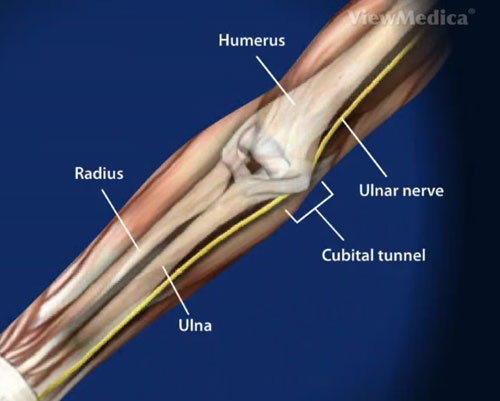
Though you may not be familiar with the medial epicondyle by its proper name, you’ve probably heard of it referred to as the funny bone. When you bump your funny bone, you experience a sharp tingling pain because the ulnar nerve runs close to the skin in that location. Cubital tunnel syndrome is caused when the ulnar nerve gets compressed around the elbow.
Cubital Tunnel Syndrome Symptoms
The ulnar nerve has several important functions hampered by cubital tunnel syndrome. This nerve provides feeling to the little finger and the adjacent half of the ring finger. The ulnar nerve also controls many hand and forearm muscles that contribute to your grip.
Symptoms of cubital tunnel syndrome include tingling or numbness in the pinky and ring finger. You may also experience pain running from the elbow down to the fingers. This can be exhibited as a burning or electrical sensation, stabbing pains, or a dull ache. Numbness, tingling, and pain are often worse when the elbow is bent, such as when driving a car. You may also feel discomfort when you do anything that applies pressure to the elbow, such as leaning on your arm.
Compression of the ulnar nerve can cause weakness in the hand. This can hamper your fine motor skills, making it hard to type, write, or play an instrument. You may feel your pinky and ring finger “fall asleep.” This creates an intense numb feeling, making moving these fingers difficult or even impossible. If cubital tunnel syndrome isn’t treated, your hand muscles may atrophy. Muscle wasting in the hand is irreversible, so seeking medical help as early as possible is important.
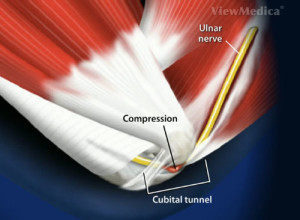

Diagnosis
Your doctor can make a preliminary diagnosis of cubital tunnel syndrome by evaluating your symptoms and performing a physical examination. They may conduct a series of simple tests to determine what exacerbates your symptoms. This may include:
- Tinel’s test: Your doctor will tap on the cubital tunnel with their fingertips to see if this elicits symptoms.
- Elbow flexion test: Your doctor will have you flex your elbow, extend your wrist with the palm facing down, and hold this position for 30 seconds to see if the position causes numbness or pain.
- Shoulder internal rotation: You’ll extend your arm to the side and bend it 90 degrees at the elbow with the forearm positioned downward to determine whether this position causes symptoms to worsen.
Your doctor may order additional imaging tests to further evaluate the nature of the condition and rule out other similar conditions, such as nerve compression at the cervical spine. You may undergo ultrasound, electromyography, or MRI testing.
Cubital Tunnel Syndrome Treatment
Cubital tunnel syndrome can be treated surgically or nonsurgically, depending on the severity of the condition. Your doctor will determine the right approach.
Nonsurgical Treatment
If symptoms are mild, you may respond to a nonsurgical treatment plan. This involves splinting the elbow at night and modifying activities during the day to minimize the time when your elbow is bent. This means you shouldn’t place your arm along the armrest or windowsill while driving, and you may need to adjust your desk’s ergonomics so you can type or use the computer mouse without bending your elbow.
Your doctor may also recommend physical therapy. Working with a hand or occupational therapist can help restore your hand and forearm function.
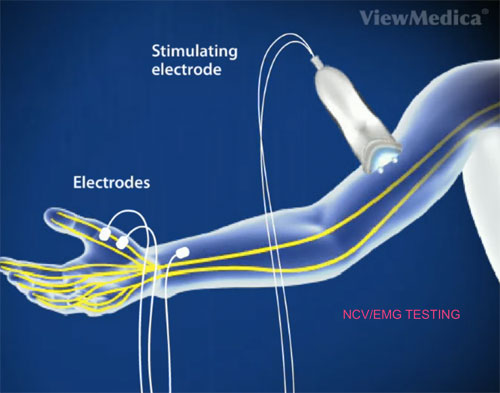
Electromyography (EMG) Animation Video
Nerve Conduction Study (NCS) Animation Video
Surgical Treatment
If nonsurgical treatments fail or you’re suffering from a severe case of cubital tunnel syndrome, you may need surgery. Cubital tunnel syndrome surgery can be approached in several ways. Your surgeon will help you understand which is best for your condition. Common options include:
- Decompression surgery: The cubital tunnel is widened surgically to give the ulnar nerve more room.
- Medial epicondylectomy: A portion of the medial epicondyle is removed to expand the cubital tunnel.
- Anterior transposition procedure: The ulnar nerve is repositioned to the front of the medial epicondyle and secured with muscle or fascia.
As you heal, you’ll need to wear a splint for two to three weeks after surgery. You should also participate in physical therapy to restore full function to your hand and arm.
Prevention
The cause of cubital tunnel syndrome isn’t always clear, making it difficult to prevent. Activities that involve repeatedly bending the elbow, such as throwing a baseball or putting constant pressure on the elbow, may irritate the ulnar nerve. You’re at a higher risk of developing cubital tunnel syndrome if you have:
- cysts near the elbow
- previously fractured or dislocated your elbow
- arthritis of the elbow
- bone spurs in your elbow
- swelling in the elbow joint
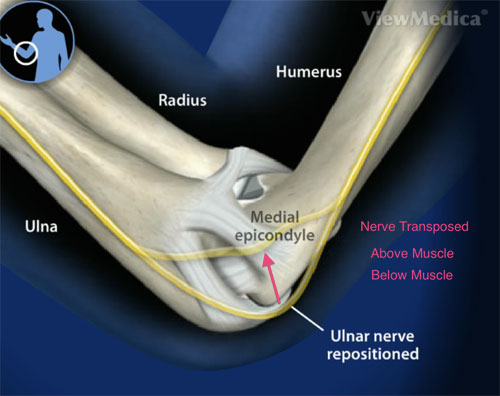
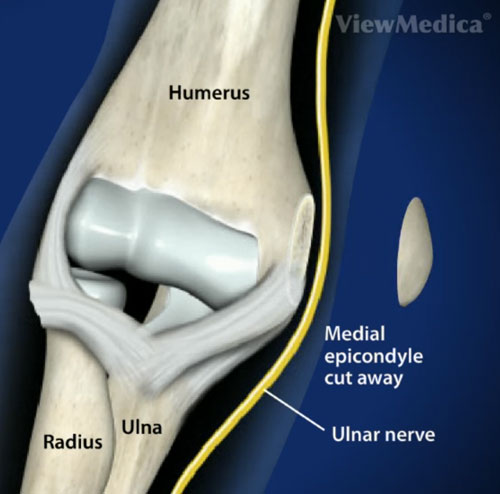
How can Dr. Knight help you with cubital tunnel syndrome?
Dr. Knight has years of significant experience in peripheral nerve surgery such as cubital tunnel syndrome. While cubital tunnel syndrome is usually resolved with non-operative treatment, if surgery becomes necessary, Dr. Knight will carefully determine with your help what your daily activities are and what sports you enjoy to determine which minimally invasive procedure is best to return you to pain-free activities quickly.
Dr. Knight is excited to be serving residents throughout the Dallas area. He’s one of the best hand doctors in Dallas and if anyone can help, he can. Come to our Dallas office or Southlake hand and wrist center at your convenience.
Cubital Tunnel Syndrome Fact Sheet
| How can I develop Cubital Tunnel Syndrome? | Cubital tunnel syndrome is caused when the ulnar nerve becomes entrapped in the cubital tunnel of the elbow, due to irritation or inflammation, as a result of overuse, trauma, arthritis, or othe inflammatory conditions. |
| How can I treat the symptoms of Cubital Tunnel syndrome at home? | There is a specific type of brace designed for Cubital Tunnel Syndrome called a Pil-O Brace that can be worn at night while sleeping to reverse the affects of the condition. These spkints and anti-inflammatory drugs can help to assuage th ediscomfort of Cubital Tunnel Syndrome |
| Are there any affective medications in combating the onset of Cubital Tunnel syndrome? | If possible, anti-inflammatory drugs can be employed to reduce inflammation around the cubital tunnel. |
| What happens if I don't seek treatment for Cubital Tunnel Syndrome? | If left untreated, and if steps arent taken to change the behaviors or activities that led to the condition, then Cubital Tunnel Syndrome can be permanent and will continue to get worse over time. |
| What is the recovery period after Cubital Tunnel syndrome has been treated? | It all depends on what sort of treatment you receive: conservative treatment can be ongoing, and may be necessary for years following the onset of symptoms to keep the condition from getting worse. In the case of surgery, a period of about four months after the operation will be necessary for return of full function to your affected arm. |
| What are the most common treatments for Cubital Tunnel Syndrome? | Anti-inflammatory drugs and splinting are the most common conservative treatments, but in more advanced cases then surgery may be necessary. |
Frequently asked Questions:
What if my Cubital Tunnel Syndrome goes untreated?
As with any condition that involves the nerves of the upper extremity, Cubital Tunnel Syndrome must be treated, otherwise it will get worse and the symptoms will increase sequentially until the sufferer essentially loses all use of the affected arm, due to increasing nerve damage.
How long will it take to recover from Cubital Tunnel Syndrome?
Recovery time for Cubital Tunnel Syndrome depends entirely on the method of treatment employed to deal with your specific case. Conservative treatment, which Dr. Knight always prefers to employ prior to resorting to surgical intervention, can be ongoing, and often requires modifications to behavior and ergonomic adaptation to keep the symptoms from recurring or getting worse. In this instance, the recovery time can be said to be the rest of your life, because once the development of symptoms starts, treatment is a matter of managing ongoing development. If your symptoms are already developed to such a point that surgery is required to relieve them, then the time required is considerably less, by comparison. After surgery, you will be wearing a splint, and could require up to 4 months of physical therapy to strengthen the newly repaired cubital tunnel.
How can you treat Cubital Tunnel Syndrome?
Cubital Tunnel Syndrome can be treated conservatively with a nightly splint known as a Pil-O Brace, which holds the elbow in extension to relieve pressure on the cubital tunnel and the cubital nerve within. This process can take up to six weeks to show effects, and it is advisable to continue use of the splint for many weeks after symptoms abate, to avoid any recurrence. If conservative treatment is not effective, or your symptoms have advanced to a point that requires it, surgery is the next route to dealing with your condition. There are three possible surgeries, the first being an anterior transposition, where the ulnar nerve is repositioned so that it no longer rubs against the tunnel’s tissue and causes pain when the elbow flexes. Alternately, decompression surgery widens the cubital tunnel and stops the rubbing on the ulnar nerve that caused the pain in the first place. Lastly, an epicondylectomy involves slicing out a part of the medial epicondyle which also enlarges the space through which the cubital tunnel passes.
Is Cubital Tunnel Syndrome permanent?
Thankfully, Cubital Tunnel Syndrome is easily treatable, whether through conservative methods or the surgical options discussed above.
Can Cubital Tunnel Syndrome be treated without surgery?
As discussed above, conservative methods of treating Cubital Tunnel Syndrome are preferred to surgery unless absolutely necessary, so the answer is yes, it can. Depending on the severity of the damage or pain suffered by the patient, however, surgery may be the only viable option for treating the condition. Typically, surgery becomes necessary when the effects of the condition are left untreated for too long, so as long as you take the initiative to see a doctor and have your pain investigated and treated as soon as possible, surgical intervention can be avoided.
Videos
Animated Videos
Surgical Video
Note: The following video contains graphic images.
Disclaimer
HandAndWristInstitute.com does not offer medical advice. The information presented here is offered for informational purposes only. Read Disclaimer



